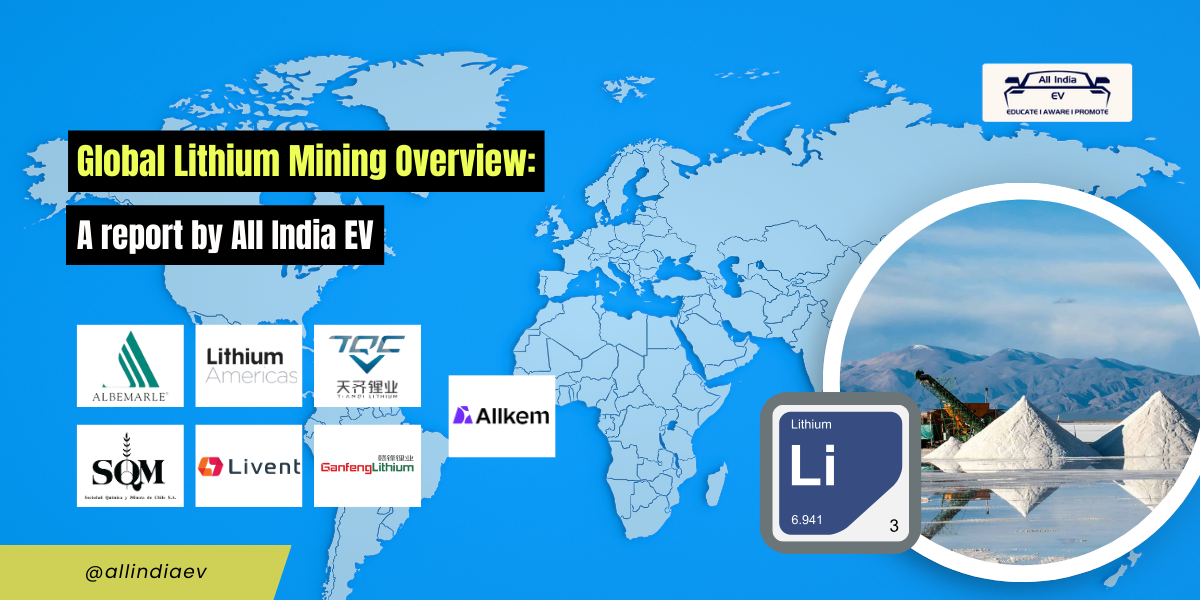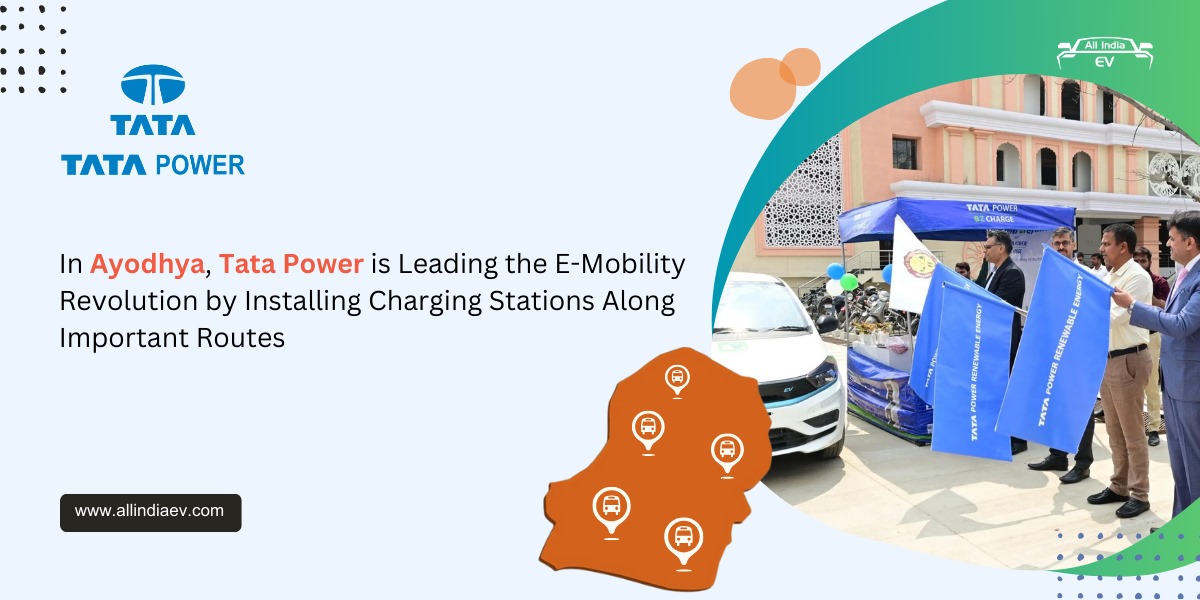
Global Lithium Mining Overview: A report by All India EV
Lithium, often referred to as “white gold,” has become one of the most critical elements in the modern industrial era, primarily due to its vital role in the production of lithium-ion batteries, which are essential for electric vehicles (EVs), renewable energy storage, and portable electronics. The growing demand for lithium, driven by the rapid adoption of electric vehicles and renewable energy technologies, has created a boom in lithium mining activities globally. The industry is dominated by several key companies, with operations spanning across regions rich in lithium reserves, particularly Australia, Chile, and China. This report provides an overview of the major players in the lithium mining industry, their operations, and the yearly production capacities from their respective mines.
Key Lithium Mining Companies
The global lithium mining industry is shaped by a handful of influential companies, which contribute significantly to the world’s lithium supply chain. Below is a summary of the top lithium mining companies based on market capitalization and production capacity:
Albemarle Corporation
- Market Cap: $33.9 billion
- Operations: Albemarle controls several key lithium production sites, including Salar de Atacama (Chile), Wodgina Mine (Australia), and Silver Peak (Nevada, USA). The company is known for its expansive lithium extraction and processing operations, which contribute to a significant portion of the global lithium supply.
- Production Capacity: Salar de Atacama produces 120,000 metric tons per year (ktpy) of lithium carbonate and 21,500 ktpy of lithium hydroxide, with plans to expand to 250 ktpy and 40 ktpy by 2025.
Sociedad Química y Minera de Chile (SQM)
- Market Cap: $29.6 billion
- Operations: SQM’s key operations are based at Salar de Atacama, Chile, where it produces lithium carbonate and lithium chloride from brine.
- Production Capacity: Salar de Atacama produces 120 ktpy of lithium carbonate and 21.5 ktpy of lithium hydroxide, similar to Albemarle’s output in the same region.
Tianqi Lithium
- Market Cap: $25.0 billion
- Operations: Tianqi Lithium holds a significant stake in the Greenbushes Mine in Australia, the largest hard rock lithium mine globally. It also operates various projects across China.
- Production Capacity: Greenbushes produces around 1,340,000 metric tons of lithium spodumene concentrate per year.
Ganfeng Lithium
- Market Cap: $22.9 billion
- Operations: Ganfeng Lithium is involved in several projects, including the Mount Marion Mine in Australia and multiple projects in China.
- Production Capacity: Mount Marion produces approximately 450,000 metric tons of lithium spodumene concentrate annually.
Mineral Resources Ltd.
- Market Cap: $9.4 billion
- Operations: Mineral Resources Ltd. has a 50% stake in the Wodgina Mine in Australia, jointly owned with Albemarle. They are also developing the Bald Hill Mine in Australia.
- Production Capacity: Wodgina Mine produces 750,000 metric tons of lithium spodumene concentrate per year.
Pilbara Minerals
- Market Cap: $8.6 billion
- Operations: Pilbara Minerals operates significant lithium projects, including the Pilgangoora and Ngungaju projects in Australia.
Allkem
- Market Cap: $6.5 billion
- Operations: Allkem’s main lithium production site is the Olaroz Lithium Facility in Argentina, which produces lithium carbonate from brine.
- Production Capacity: Olaroz produces 42,000 metric tons of lithium carbonate annually.
Livent
- Market Cap: $6.2 billion
- Operations: Livent is involved in lithium hydroxide production in the USA, focusing on both brine and hard rock sources.
- Production Capacity: Livent produces approximately 20,000 metric tons of lithium hydroxide per year.
Sichuan Yahua Industrial
- Market Cap: $4.8 billion
- Operations: Sichuan Yahua Industrial operates several lithium extraction projects in China.
Lithium Americas
- Market Cap: $4.2 billion
- Operations: Lithium Americas is developing the Thacker Pass project in Nevada, USA, and is also involved in the Cauchari-Olaroz project in Argentina.
- Production Capacity: Thacker Pass is expected to produce 66,000 metric tons of lithium carbonate annually once operational.
Major Lithium Mines and Their Production Capacities
The table below outlines the key lithium mines controlled by the leading companies and their yearly production capacities.
| Company | Mine | Location | Production Capacity |
| Albemarle Corporation | Salar de Atacama | Chile | 120,000 metric tons of lithium carbonate |
| Albemarle Corporation | Wodgina Mine | Australia | 750,000 metric tons of lithium spodumene concentrate |
| Sociedad Química y Minera | Salar de Atacama | Chile | 120,000 metric tons of lithium carbonate |
| Tianqi Lithium | Greenbushes Mine | Australia | 1,340,000 metric tons of lithium spodumene concentrate |
| Ganfeng Lithium | Mount Marion Mine | Australia | 450,000 metric tons of lithium spodumene concentrate |
| Allkem | Olaroz Lithium Facility | Argentina | 42,000 metric tons of lithium carbonate |
| Livent | Lithium Hydroxide Operations | USA | 20,000 metric tons of lithium hydroxide |
| Lithium Americas | Thacker Pass | USA | 66,000 metric tons of lithium carbonate (once operational) |
Global Lithium Supply Chain
The global lithium supply chain is deeply interconnected, with these major players controlling vast reserves and production capabilities. Australia is home to some of the world’s largest lithium mines, while Chile remains a leader in lithium brine extraction. China, despite not having the largest reserves, plays a crucial role in lithium refining and production, making it a dominant force in the lithium-ion battery supply chain. This supply chain is critical for the production of batteries used in electric vehicles (EVs), consumer electronics, and energy storage systems.
Conclusion
The lithium mining industry is set to continue its rapid growth in response to the increasing demand for lithium-ion batteries, primarily driven by the transition to electric vehicles and renewable energy storage solutions. The leading companies in the sector, such as Albemarle, SQM, Tianqi Lithium, and Ganfeng, are not only expanding their current production capacities but also investing in new technologies and projects to secure their dominance in the global market. As demand continues to outstrip supply, we can expect to see further expansions and new projects to come online, further shaping the future of the lithium mining landscape.









